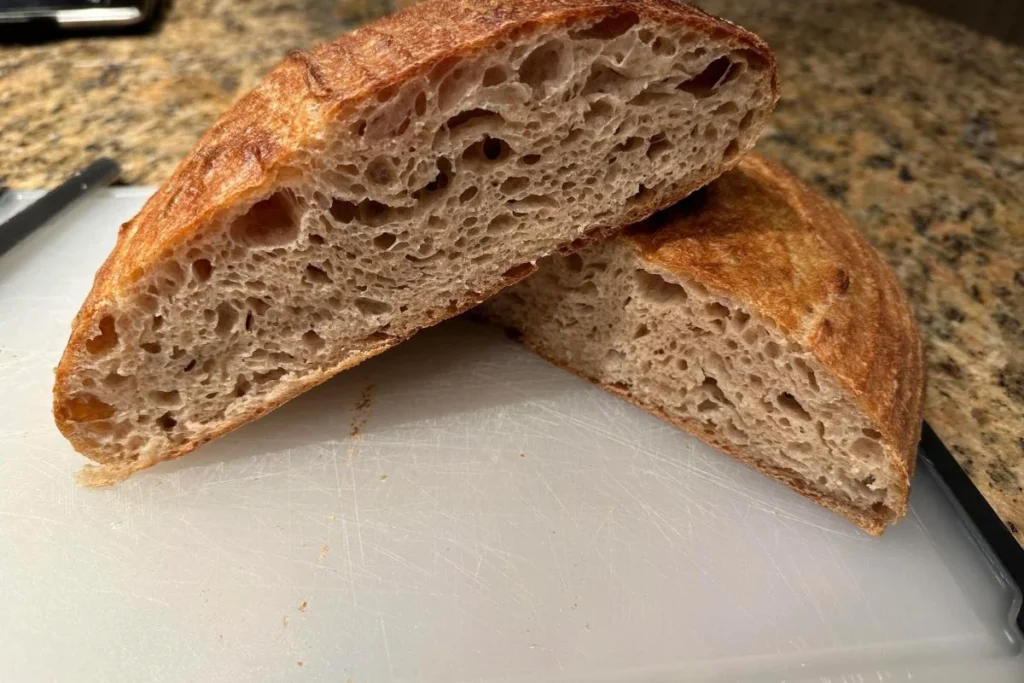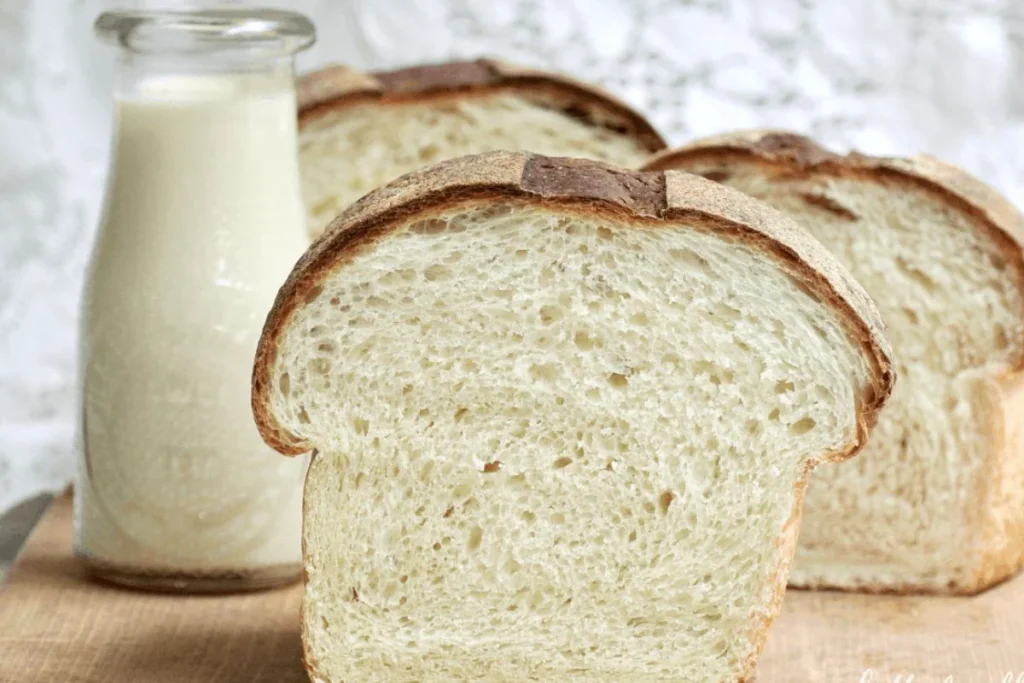
4 Easy Ways to Fix Sourdough Bread That’s Too Flat
Baking sourdough bread has become a cherished art form for many enthusiasts, including myself. Yet, like any artistic pursuit, it comes with its fair share of challenges. One big problem folks often run into is ending up with flat sourdough bread, which can be pretty disappointing after putting in all that time and effort to ferment it.
But don’t worry! In this blog post, I’ll cover four simple ways to solve the problem of flat sourdough bread. Plus, we’ll look into why sourdough loaves sometimes turn out flat.
Table of Contents
Toggle5 Main Reasons Why Your Sourdough Bread Is Flat
Making sourdough bread is like an art form that takes practice and patience. But sometimes, your loaf just doesn’t turn out right. Here are four common reasons why your sourdough might end up flat.
Reason 1: Not Letting It Ferment Enough
One big deal with sourdough bread is fermentation. If it doesn’t ferment long enough, your loaf might turn out dense and flat. Sourdough needs wild yeast and bacteria to make bubbles in the dough.
If you rush the fermenting, those little guys won’t have time to make enough gas, and your bread won’t be fluffy. Make sure to let your sourdough sit for 12 to 24 hours, depending on stuff like how warm it is and how strong your starter is.
Reason 2: Weak Sourdough Starter
Having a strong starter is super important for making your bread rise. If your starter is not robust enough, it won’t be able to puff up your dough properly. Keep your starter well-fed and happy to boost its activity.
A good starter should double in size within a few hours of feeding and have lots of bubbles. If your starter seems weak, try feeding it more often or using more water.
Reason 3: Not Handling the Dough Right
How you treat your dough while you’re baking can change how it turns out.
If you mix it too much or too little, shape it wrong, or excessive handling during shaping, you might end up with a flat loaf. Be gentle with your dough, especially when shaping it, to keep those bubbles from fermenting.
And make sure it’s got some tension when you shape it to help it rise in the oven.
Reason 4: Inconsistent Proofing Conditions
Proofing, or letting your dough rise before baking, is super important. If the conditions aren’t right—like if it’s too hot or too dry—it might not rise properly.
Keep things warm and consistent while your dough proofs, and try poking it with your finger to see if it’s ready for baking. A well-proofed dough will keep its shape and give you a nice, fluffy loaf.
Reason 5: Too Much Water in Your Dough
Getting the water level just right is super important when you’re making sourdough bread. Water helps the gluten form properly, but if there’s too much of it, your dough can get weak.
That means instead of puffing up nicely in the oven, it might spread out too much. Keep an eye on how much water you’re adding, and tweak it as necessary depending on things like the kind of flour you’re using and the weather.

How To Fix Sourdough Bread That’s Too Flat in 4 Easy Ways
Flat sourdough bread can be a letdown, but the good news is there are simple ways to fix it. In this guide, we’ll go through four effective methods to bring your sourdough back to life and get that nice rise you’re aiming for.
Technique 1: Refreshing Your Starter
The foundation of a good sourdough loaf lies in a healthy and active starter. If your starter is not at its peak strength, it can result in a lackluster rise and a flat final product. Refreshing your starter involves feeding it with a mixture of flour and water to rejuvenate its yeast and bacterial activity.
To refresh your starter, follow these steps:
- Discard a portion of your existing starter, leaving only a small amount in the container.
- Add equal parts of flour and water to the remaining starter. For example, if you have 100 grams of starter, add 50 grams of flour and 50 grams of water.
- Mix the ingredients thoroughly and let the starter sit at room temperature for 4-6 hours, or until it becomes bubbly and doubles in size.
- Use this refreshed starter in your sourdough recipe.
By ensuring your starter is robust and active, you provide a strong foundation for the fermentation process, promoting better dough rise and a more voluminous loaf.
Technique 2: Adjusting Hydration Levels
The hydration level of your sourdough dough significantly impacts its final texture. If your bread is consistently turning out flat, it might be due to improper hydration. Too much water can lead to a sticky dough, while too little can result in a dry and dense loaf.
To adjust hydration levels:
- Start by reducing or increasing the amount of water in your recipe by small increments (e.g., 5-10%). Note the changes in dough consistency.
- Pay attention to how the dough feels during the various stages of mixing and folding. A well-hydrated dough should be elastic and slightly sticky, not overly wet or dry.
- Experiment with different hydration levels to find the sweet spot for your desired bread texture.
Remember that environmental factors such as humidity can also affect dough hydration. By fine-tuning the water content in your recipe, you can achieve a more consistent and desirable rise in your sourdough bread.

Technique 3: Proper Shaping and Scoring
The shaping and scoring of your sourdough loaf play a crucial role in its final appearance and structure. Flat loaves can often be attributed to inadequate shaping or scoring techniques. Properly shaping the dough creates tension on the surface, allowing it to hold its shape during fermentation and baking.
Follow these steps for effective shaping and scoring:
- After the bulk fermentation stage, turn the dough out onto a lightly floured surface.
- Gently fold the edges of the dough toward the center, creating tension on the surface. Repeat this process until you have a taut ball of dough.
- Allow the dough to rest for a short period before shaping it into a round or oval loaf, depending on your preference.
- When scoring, use a sharp blade or lame to make shallow cuts on the surface of the dough. This helps control the expansion of the bread during baking.
Proper shaping and scoring promote an even rise, prevent the dough from spreading too much, and contribute to a more appealing final appearance. Experiment with different shaping techniques to find what works best for your specific sourdough recipe.
Technique 4: Correct Baking Temperatures and Times
Baking sourdough bread involves a delicate balance between time and temperature. Incorrect baking temperatures or durations can result in an underwhelming oven spring and a flat final product. Ensure your oven is preheated adequately and that you follow the recommended baking times for your recipe.
Consider the following tips for optimal baking:
- Preheat your oven to the specified temperature in your recipe at least 30 minutes before baking. This allows the oven and any baking stone or Dutch oven to reach the desired temperature evenly.
- Use a kitchen thermometer to verify the internal temperature of your bread. A fully baked sourdough loaf should register between 200-210°F (93-99°C).
- Experiment with steam during the initial stages of baking to create a humid environment, promoting a better oven spring and crust development.
By paying close attention to your baking temperatures and times, you can ensure that your sourdough bread rises adequately in the oven, resulting in a well-structured and visually appealing loaf

Troubleshooting Tips for Reviving Flat Sourdough Bread
Even if you’re doing your best, sometimes your sourdough bread might still end up flat. But don’t get down about it! Instead, try these tips to bring your sourdough loaves back to life and make them better.
- Check Your Starter: First things first, take a look at your sourdough starter. If it’s not looking lively or growing like it should when you feed it, that could be part of the problem. You want it to double in size and show lots of bubbles before you use it.
- Check Dough Consistency: The texture of your dough matters a lot. If it’s too sticky or too dry when you’re shaping it, it might not rise properly. Tweak how much water you’re using until you get a dough that feels just right.
- Review Fermentation Times: How long you let your dough ferment and proof is key to getting that nice rise. If your bread keeps coming out flat, try giving it a bit more time during these stages. Make sure your dough doubles in size during fermentation and gets all puffy during proofing.
- Experiment with Flour Types: The kind of flour you use can affect how your bread turns out. Different flours have different proteins, which can change how your dough forms. If your bread’s consistently flat, try mixing up your flour or using kinds with more protein to help it rise better.
- Get Your Oven Ready: The final rise in the oven is super important. Make sure your oven’s nice and hot before you put your bread in, and think about cutting deeper slashes in your dough to help it expand. Using steam in the oven at the start can also give your bread a boost.
- Be Patient: Sourdough baking takes time and practice. Don’t get discouraged if your first few loaves don’t turn out perfect. Take notes, try new things, and you’ll get the hang of it over time.
Creative Ways to Repurpose Flattened Sourdough Bread
There are some cool ways to use up flattened sourdough bread, making it into something tasty instead of just a kitchen oops.
- Fancy Croutons: Change your flat sourdough into fancy croutons. Cut the bread into cubes, mix it with olive oil, garlic, and your favorite herbs, then bake until it’s crispy and golden. These croutons give salads and soups an extra yummy crunch.
- Yummy Bread Pudding: Give your flat sourdough a new life as a yummy bread pudding. Mix the bread with eggs, milk, sugar, and whatever spices you like. Bake it until it’s all set, making a comforting dessert or breakfast treat.
- Tasty Bread Crumbs: Grind up flattened sourdough into tasty breadcrumbs. These homemade crumbs add a special texture to dishes like mac and cheese or baked casseroles. Mix in some herbs and Parmesan cheese to customize the flavor.
- Panzanella Salad: Try using flat sourdough in a Panzanella salad for a fresh twist. Mix cubed bread with ripe tomatoes, cucumbers, red onions, and fresh herbs. Drizzle it with olive oil and balsamic vinegar for a delicious summer salad.
Is Flat Sourdough Still Good?
If your sourdough has gone flat but still smells and tastes good, it may be safe to consume. Flatness in sourdough can be caused by factors such as overproofing or issues with the starter.
However, as long as there are no signs of spoilage (off smells, mold, or unusual colors), it should be fine to eat.
Conclusion
Fixing flat sourdough bread is a matter of understanding the factors that contribute to its rise and adjusting your techniques accordingly.
By refreshing your starter, fine-tuning hydration levels, mastering shaping and scoring, and paying attention to correct baking temperatures and times, you can overcome the challenges of flat loaves and achieve the desired results in your sourdough baking journey.
Experimentation is key, so don’t be afraid to make adjustments and refine your process until you find the perfect formula for your ideal sourdough bread.
Lindsey Mackenzie
About me
Hi there! I’m Lindsey Mackenzie, the founder of Bake Smartly. Baking has been my passion since childhood, growing up in my father’s bakery. With Bake Smartly, I’m excited to share my love for all things sweet and savory. Join me on this delicious journey as we whip up scrumptious treats and sprinkle joy into every bite!






